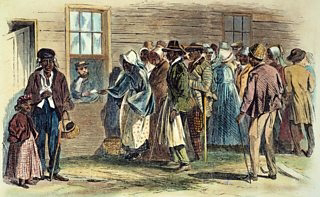The Cafe' [Think Tank]- Released tape features Ronald Reagan using racist slur
Why Trickle Down Economic Works in Theory But Not in Fact
Trickle-down economics is a theory that claims benefits for the
wealthy trickle down to everyone else. These benefits are tax cuts on
businesses, high-income earners, capital gains, and dividends.
Trickle-down economics assumes investors, savers, and company owners
are the real drivers of growth. It promises they’ll use any extra cash
from tax cuts to
expand businesses. Investors will buy more companies or stocks. Banks
will increase lending. Owners will invest in their operations and hire
workers. All of this expansion will trickle down to workers. They will
spend their wages to drive demand and economic growth.
Trickle-Down Economic Theory
Trickle-down economic theory is similar to supply-side economics. That theory states that all tax cuts, regardless of whether they are for businesses or workers, spur economic growth.
Trickle-down theory is more specific. It says targeted tax cuts work
better than general ones. It advocates cuts to corporations,
capital gains, and savings taxes. It doesn't promote across-the-board
tax cuts. Instead, the tax cuts go to the wealthy.
Both trickle-down and supply-side proponents use the Laffer Curve to
prove their theories. Arthur Laffer showed how tax cuts provide a
powerful multiplication effect. Over time, they create enough growth to
replace the government revenue lost from the cuts. The resulting expanded, prosperous economy provides a larger tax base.
But Laffer warned that this effect works best when taxes are in the
"Prohibitive Range." This range goes from a 100 percent tax rate down to
an unspecified rate around 50 percent.
If the tax rate falls below the Laffer Curve's prohibitive range, then further cuts won't stimulate economic growth enough to offset the lost revenue.
When Trickle-Down Policies Work
During the Reagan administration, it seemed like trickle-down economics worked. The administration's policies, known as Reaganomics, helped end the 1980 recession.
Reagan cut taxes significantly. The top tax rate fell from 70 percent
for those earning $108,000 or more to 28 percent for anyone with an
income of $18,500 or more. Reagan also cut the corporate tax rate from 46 percent to 40 percent.
Trickle-down economics was not the only reason for the recovery, though. Reagan also increased government spending by
2.5 percent a year. He almost tripled the federal debt from $997
billion in 1981 to $2.85 trillion in 1989. Most of the spending went to
defense. It supported Reagan's efforts to end the Cold War and bring
down the Soviet Union.
Trickle-down economics, in its pure form, was never tested. It's just
as likely that massive government spending ended the recession.
President George W. Bush used trickle-down policies to address the 2001 recession. He cut income taxes with the Economic Growth and Tax Relief Reconciliation Act. That ended the recession by November of that year.
But unemployment rose to 6 percent.
That often occurs because unemployment is a lagging indicator. It takes
time for companies to start hiring again, even after a recession has
ended. As a result, Bush cut business taxes with the Jobs and Growth Tax Relief Reconciliation Act in 2003.
It appeared that the tax cuts worked. But, at the same time, the Federal Reserve lowered the fed funds rate. It fell from 6 percent to 1 percent. In this situation, it's unclear whether tax cuts or monetary policy caused the recovery.
Trickle-down economics says that the Reagan and Bush tax cuts should
have helped people at all income levels. Instead, the opposite
occurred. Income inequality worsened. Between 1979 and 2005, after-tax household income rose 6 percent for the bottom fifth.
That sounds great until you see what happened for the top fifth. Their
income increased by 80 percent. The top 1 percent saw their income
triple. Instead of trickling down, it appears that prosperity trickled
up.
Why Trickle-Down Economics Is Relevant Today
Republicans continue to use trickle-down economic theory to guide policy.
On December 22, 2017, President Trump signed the Tax Cuts and Jobs Act. It cut the corporate tax rate from 35 percent to 21 percent beginning in 2018. The top individual tax rate drops to 37 percent. Trump's tax plan cuts income tax rates, doubles the standard deduction, and eliminates personal exemptions. The corporate cuts are permanent while the individual changes expire at the end of 2025.
The Tax Policy Center found that
those earning in the top 1 percent would receive a larger tax cut
percentage than those in lower income levels. By 2027, those in the
lowest 20 percent income levels would pay higher taxes.
Though Trump said it would boost growth enough to make up for the debt increase, the Joint Committee on Taxation reported that
the Act would add $1 trillion even after including the tax cut's impact
on economic growth. It wouldn't spur growth enough to offset the cuts'
loss in revenue.
In 2010, the Tea Party movement
rode into power during the midterm elections. They wanted to
cut government spending and taxes. As a result, Congress extended the Bush tax cuts, even for those making $250,000 or more.


Comments
Post a Comment